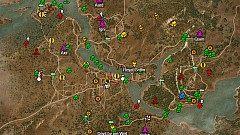
The Witcher 3 graphics settings explained and benchmarked
Postprocess Effects:
The following settings are further graphics options, but aren’t found under the Graphics Options menu. Look for these in the Postprocess menu.
Motion Blur
This setting determines the strength of the motion blur in use. Motion Blur is especially useful when running at a lower framerate such as 30 FPS to make movement and camera movement feel smoother. We encountered a 2 FPS drop with motion blur enabled.

Bottom Line: Enabling motion blur has a 2 percent impact on performance. Motion blur is a matter of personal preference. If you like the effect, leave it on.
Blur
This is a subtle post-process blur effect. We didn’t notice any visual difference with it on or off. Enabling Blur incurred a 2 FPS hit.

Bottom Line: Enabling blur has a 2 percent impact on performance. The effect isn’t really noticeable, but then again, the performance penalty isn’t either. We weren’t able to spot the difference, but you may want to leave it on if you notice a qualitative improvement.
Anti-Aliasing
Anti-Aliasing refers to techniques used to eliminate aliasing, which refers to the “jaggies” seen on diagonals and curved surfaces. The Witcher 3’s engine doesn’t support traditional MSAA. Instead, CDPR have opted for an advanced temporal post-process anti-aliasing solution. While it has a slight performance hit, AA coverage is excellent for a post-process technique. We experienced a 3 FPS drop with Anti-Aliasing enabled.

Bottom Line: Anti-Aliasing has a 4 percent impact on performance. You should leave Anti-Aliasing enabled—CDPR have developed one of the most effective post-process AA techniques we’ve seen in a while.
Bloom
Bloom is a cinematic post-process filter that adds an atmospheric glow to brightly lit and reflective surfaces. Bloom is especially useful in enhancing The Witcher 3’s ethereal atmosphere. We encountered a 3 FPS drop with Bloom enabled.

Bottom Line: Bloom has a 4 percent impact on performance. We suggest leaving bloom on. Disabling it can take away from the rich fantasy atmosphere of The Witcher 3.
Sharpening
We saw the sharpening filter last in The Witcher 2, where it remained on by default. The Sharpening filter works the same way as the “sharpen” option in software like GIMP or Photoshop. Sharpening is a subtle effect, but it trades slightly more detailed visuals for a slightly grainier image.

Bottom Line: Sharpening has a 4 percent impact on performance. We recommend enabling this setting, particularly if you’re running at lower resolutions as it really bring out texture detail.
Ambient Occlusion
This setting determines the type of Ambient Occlusion used. Ambient Occlusion is a technique to render indirect shadows—for instance, the shadowing inside of a shelf. Ambient Occlusion is disabled when this is set to off. The other two options are standard SSAO and HBAO+, the latter being exclusive to Nvidia cards. SSAO incurred a 5 FPS hit, while enabling HBAO+ dropped our framerate by 6 FPS from the baseline.

Bottom Line: Ambient Occlusion has a 6-7 percent impact on performance. Disabling Ambient Occlusion entirely can make most scenes, especially interiors, look flat and lacking in depth. We recommend setting this to HBAO+ if you’re on Nvidia hardware and to SSAO otherwise, but we do not recommend disabling it.

